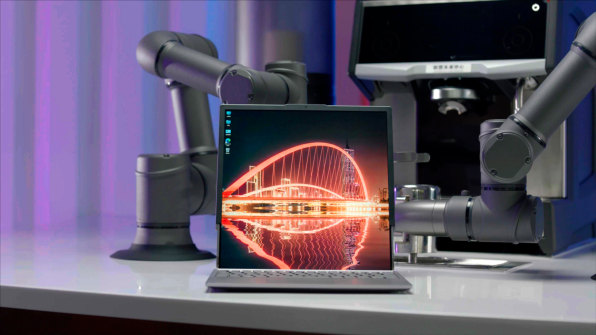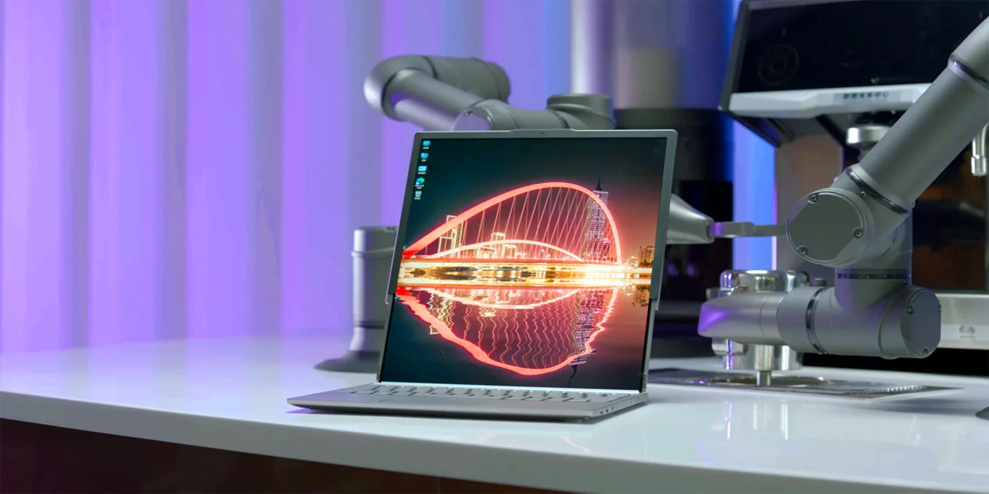Lenovo’s new concept laptop goes from landscape to portrait, the 21st century version of the Radius Pivot monitors from the ’90s.
Here’s yet another doodad that nobody asked for: a laptop with a typical landscape screen that mechanically unrolls into a tall, portrait mode. It increases its vertical resolution so you can, say, better edit a TikTok, massage the pixels on a vertical portrait, or write a business report in full-page mode.
The newly unveiled concept is made by Lenovo, a company that seems to love flexible displays and foldable things in general. As Brian Leonard, VP of design for Lenovo Intelligent Devices Group, tells me over email, this device was born from their perennial quest to discover new form factors, which started when they released the first laptop that turned into a tablet: the IBM ThinkPad 360P (Lenovo bought IBM’s PC business in 2005). “The beauty of a rollable form-factor laptop PC is that it can expand into a much larger screen real estate as the content dynamically adjusts to the screen, offering people an unprecedented way of hyper-tasking for productivity, browsing, and more,” he says.
That sounds cool, but I still really hate this thing. Wait, no, I actually love it, and I hate myself for that.[Image: Lenovo]
THE 50-YEAR QUEST FOR FOLDING DISPLAYS
The journey to modern foldable screens has been slow and filled with roadkill. The first flexible display was invented at Xerox PARC in Palo Alto, almost 50 years ago. Nick Sheridon—an engineer at the legendary research center that gave us the graphic interface and the laser printer, which led to modern computing as we know it—made a digital paper full of microscopic beads that were half white and half black. Floating in cavities full of liquid, these spheres rotated to form images like a page printed with living toner. These papers evolved to shine in products like Kindle, but companies trying to do full-color foldable displays failed until the refining of organic light-emitting diodes (OLEDs), which were invented by Kodak in the late ’80s. After many tried, LG created the first flexible OLED panels that could compete with LCD screens. The current generation works so well that it outperforms LCD with much higher contrast and color saturation. Its flexible screens are durable, convenient, and they look as gorgeous as their rigid counterparts.
Take LG itself, which makes spectacular TVs that smoothly fold and roll like croissant dough, all while offering eye-stabbing sharpness and quality, like the LG Signature R. Along the same lines, Samsung’s foldable phones, seemingly the most popular and recognizable products in the category, have reached a level of sophistication and durability with an affordable price that makes them rather attractive—even compared to high-end soap bars like the iPhone. But these folding products are all niche. The LG is priced for the 0.5%, and Samsung only sold about 10 million foldables in 2021—but a remarkable increase compared to the 1.2 million units it sold in 2019 and 2020 combined—still, a footnote compared to the 1.39 billion phones sold in the same year (242 million of which were iPhones).

LOVE AND HATE
Lenovo is giving folding-display technology yet another try with this new form factor. They already had released a foldable-screen device, the $2,500 16-inch ThinkPad X1 Fold. What they called “the first foldable PC” was, technically, a foldable tablet running Windows. This new concept, however, really is a laptop.
I love this polarizing design because the tech world is a bore dominated by iterative Apple, the lather-rinse-repeat Apple, the Apple-is-the-new-beige Apple. So I just can’t resist companies that try new stuff, no matter how niche or absurd it may seem (and this laptop seems plenty niche!). Especially if, after 50 years of industry efforts, any company can make flexible displays useful at last.
BUT! It doesn’t matter that these folding products from LG, Samsung, and Lenovo are technical achievements. They have yet to realize the sci-fi dream of a world full of magical devices that seamlessly expand and collapse on a whim.
BUT! Lenovo’s design does look quite spectacular in this video, as it smoothly stretches its screen to the sky, thanks to an electric motor. As the screen grows, the display reveals more pixels. “This is the first-of-its-kind laptop computer prototype at 13-inch and 4:3 aspect ratio, that can expand into a 16-inch screen with 8:9 aspect ratio (or two 16:9 screens),” Leonard points out. He says that, simply put, this design offers a lot more screen real estate in the same compact laptop form factor.
BUT! This laptop is also a very stupid thing. Who wants a laptop that can extend its screen vertically? An influencer who wants to edit video vertically on a computer? A stock trader who wants windows on top of each other? What kind of imbecile would want to use this feature? (Myself from 1995, of course. That’s when I lusted after the very expensive Radius Pivot display that would allow me to edit a full page in QuarkXpress. A full page. Then 21- and 24-inch displays big enough to edit two full pages side-to-side came, and my Radius dream—and the company—died).
BUT! Leonard tells me that the laptop was developed following extensive users’ feedback, which may be indicative of real market potential, even while he says there are no product plans yet (“but stay tuned”). He believes that this product “is a game-changer for user performance and portability like never before.”
BUT! I find it hard to believe that anyone but true power users would be willing to spend the extra money to get such a device—much as it happened with the Radius Pivot, a product that had a limited loyal user base and ultimately died.
BUT! Who can really say no to a screen that gets bigger at the touch of a button? Not me. I can always use some extra space, if only to have two windows on top of each other. Or to read comic books. Or write this article on a full page.
BUT! Wait, there’s already the iPad Pro for that. If I want to edit things on a full vertical page, taking advantage of the entire screen’s real estate, I can rotate the iPad to do that. It may not have the extra pixels that the Lenovo concept provides, but it works just fine.
All of this back and forth between my brain and my bowels can only mean two things. One, this extendable Lenovo laptop is a really cool machine that doesn’t need to be made. And the other, maybe we still have to find the killer, must-have use for foldable-screen technology. Perhaps the tech itself is not sophisticated enough yet. Maybe it needs to be much thinner and more convenient, to have the allure of the folding phablets you can see in Westworld.
Or maybe we just don’t need any of this gimmicky crap, and we just need to jump straight to the infinite work area of contact lenses and brain implants. If we have to keep living our high-tech fantasies on sci-fi fuel, let’s at least do it right.
—
This article first appeared www.fastcompany.com
Seeking to build and grow your brand using the force of consumer insight, strategic foresight, creative disruption and technology prowess? Talk to us at +971 50 6254340 or engage@groupisd.com or visit www.groupisd.com/story

